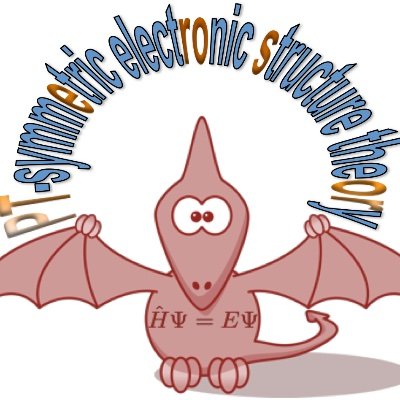
Pierre-Francois Loos
@TitouLoos
Followers
2K
Following
3K
Media
72
Statuses
2K
Theoretical chemist @CNRS @LCPQ_UMR5626 interested in excited states and developing @quantum_package #compchem #ercCoG
Toulouse, France
Joined March 2013
Complex Absorbing Potential Green’s Function Methods for Resonances | Journal of Chemical Theory and Computation https://t.co/dpgoA1rNsg
#compchem
pubs.acs.org
The complex absorbing potential (CAP) formalism has been successfully employed in various wave function-based methods to study electronic resonance states. In contrast, Green’s function-based methods...
0
0
2
[2510.23275] Analytic $G_0W_0$ gradients based on a double-similarity transformation equation-of-motion coupled-cluster treatment #compchem
arxiv.org
The accurate prediction of ionization potentials (IPs) is central to understanding molecular reactivity, redox behavior, and spectroscopic properties. While vertical IPs can be accessed directly...
0
0
1
Fully Analytic Nuclear Gradients for the Bethe–Salpeter Equation | The Journal of Physical Chemistry Letters https://t.co/44bAwZ5YwD
#compchem
pubs.acs.org
The Bethe–Salpeter equation (BSE) formalism, combined with the GW approximation for ionization energies and electron affinities, is emerging as an efficient and accurate method for predicting optical...
0
5
15
https://t.co/JQxdwEV2Yu Exploring the "Connections between Richardson-Gaudin States, Perfect-Pairing, and Pair Coupled-Cluster Theory." #compchem @TitouLoos @johnsontheochem
arxiv.org
Slater determinants underpin most electronic structure methods, but orbital-based approaches often struggle to describe strong correlation efficiently. Geminal-based theories, by contrast,...
0
2
6
[2510.06144] Connections between Richardson-Gaudin States, Perfect-Pairing, and Pair Coupled-Cluster Theory #compchem
arxiv.org
Slater determinants underpin most electronic structure methods, but orbital-based approaches often struggle to describe strong correlation efficiently. Geminal-based theories, by contrast,...
0
2
5
[2509.03253] Parquet theory for molecular systems. I. Formalism and static kernel parquet approximation #compchem
arxiv.org
The $GW$ approximation has become a method of choice for predicting quasiparticle properties in solids and large molecular systems, owing to its favorable accuracy-cost balance. However, its...
0
1
11
The call for the first 2y postdoc position on this new project with a start by early 2026 (Jan/Feb) is now live: https://t.co/itjCfMVqcj Please share & repost. Deadline is 14 Sept. Copenhagen is a truly wonderful place to live and we offer excellent terms of employment at DTU.
efzu.fa.em2.oraclecloud.com
Postdoctoral position within a new long-term project funded by the Novo Nordisk Foundation concerned with the development of novel computational methods for simulating chemical properties inherent to...
Very excited to announce that I’ve been awarded a research grant from the @novonordiskfond of 10M DKK (1.34M EUR) under the New Exploratory Research and Discovery (NERD) programme to work on a new 5y electronic-structure project beginning by early-2026. https://t.co/gHmB49vqOG
1
8
13
QUEST Database of Highly-Accurate Excitation Energies | Journal of Chemical Theory and Computation https://t.co/VJqnkRkNBq
#compchem
pubs.acs.org
We report theoretical best estimates of vertical transition energies (VTEs) for a large number of excited states and molecules: the quest database. This database includes 1489 aug-cc-pVTZ VTEs (731...
0
8
44
First paper by Loris Burth showing how to use GW with CAP in collaboration with @FKossoski. Found out that qsGW is basically as accurate as EA-EOM-CCSD for shape resonances for a lower computational cost @LCPQ_UMR5626 @pterosor #compchem
[2507.03496] Complex Absorbing Potential Green's Function Methods for Resonances #compchem
0
2
10
[2507.03496] Complex Absorbing Potential Green's Function Methods for Resonances #compchem
arxiv.org
The complex absorbing potential (CAP) formalism has been successfully employed in various wavefunction-based methods to study electronic resonance states. In contrast, Green's function-based...
0
1
9
[2507.02160] Fully Analytic Nuclear Gradients for the Bethe--Salpeter Equation #compchem
arxiv.org
The Bethe-Salpeter equation (BSE) formalism, combined with the $GW$ approximation for ionization energies and electron affinities, is emerging as an efficient and accurate method for predicting...
0
4
24
Very excited and proud of this incredible team effort #compchem
Microsoft researchers achieved a breakthrough in the accuracy of DFT, a method for predicting the properties of molecules and materials, by using deep learning. This work can lead to better batteries, green fertilizers, precision drug discovery, and more. https://t.co/LuH7ZFgyVv
2
21
106
We put chemical space (in GMTKN55) on a hardcore diet to produce Slim sets, that summarise the original data using small molecules only. Designed for people working on cutting-edge new approaches with inefficient code. 1/n https://t.co/cMlw9JI0ae
pubs.acs.org
The construction of large benchmark sets has accelerated advancement of quantum chemistry methods, especially in density functional theory and lower-cost methods. However, these large benchmark sets...
1
4
16
The third general congress of the @GDR_NBODY research network is underway at the @Univ_Lorraine. Talks by Matteo Gatti, Marios-Petros Kitsaras, Christian Schilling (@TQPSchilling) and Jeremy Morere. Thank you everyone for making the trip to Nancy! #compchem
0
1
4
🦣 update of #QUESTDB (Database of Highly-Accurate Excitation Energies) 🦖 Latest #preprint on #QUESTDB is just out on @arXiv ( https://t.co/V1Tkvy8pd8) with its @github repo ( https://t.co/6YHMEMi0S6) where we have compiled all the data in various formats. Please share! #compchem
github.com
QUESTDB: A Database of Highly-Accurate Excitation Energies - pfloos/QUESTDB
1
5
19
25.1 release of MRCC #compchem package at https://t.co/hBcIe18i04: - feature review paper: https://t.co/Z4oh4ONwSx - basis set corrected double-hybrid DFT: https://t.co/MFNBYIAAdQ - MPI+OpenMP parallel & reduced-cost explicitly correlated MP2 & CCSD(T):
pubs.acs.org
Parallel algorithms to accelerate explicitly correlated second-order Mo̷ller–Plesset (MP2) and coupled-cluster singles and doubles with perturbative triples [CCSD(T)] calculations and benchmarks on...
0
10
41
The 2nd workshop on emerging excited state methods is under way! Thank you all for traveling to Toulouse. #compchem
https://t.co/OPswA6u80D
0
1
7
Excited-state-specific Kohn–Sham formalism for the asymmetric Hubbard dimer https://t.co/rJO73xKwoV
#compchem
pubs.aip.org
Building on our recent study [Giarrusso and Loos, J. Phys. Chem. Lett. 14, 8780 (2023)], we explore the generalization of the ground-state Kohn–Sham (KS) formal
0
2
17
Anomalous propagators and the particle–particle channel: Bethe–Salpeter equation https://t.co/PiOKqonBGm
#compchem
pubs.aip.org
The Bethe–Salpeter equation has been extensively employed to compute the two-body electron–hole propagator and its poles, which correspond to the neutral excita
0
1
16
Our latest work on ``exotic" ideas to develop accurate approximations for the KS potential is published open access. Check it out! https://t.co/HqQn9FTjcu
#comotionfunctions
@FedericaAgosti9
pubs.aip.org
We model the Hartree-exchange–correlation potential of Kohn–Sham (KS) density-functional theory adopting a novel strategy inspired by the strictly correlated-el
0
7
19





















